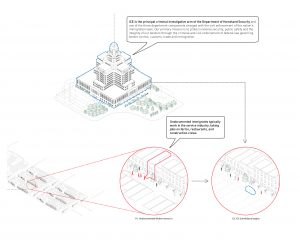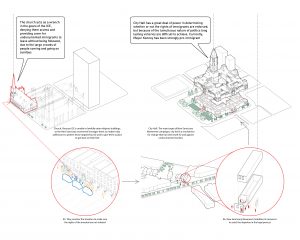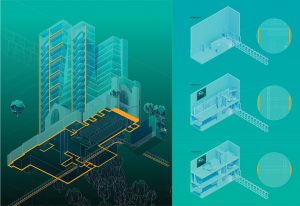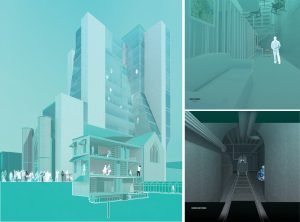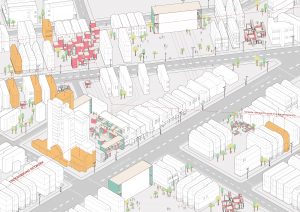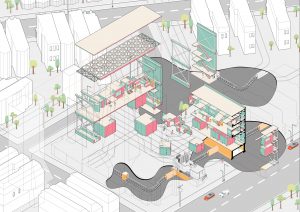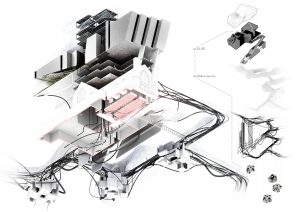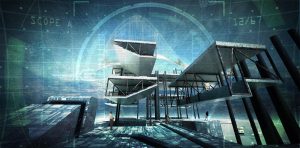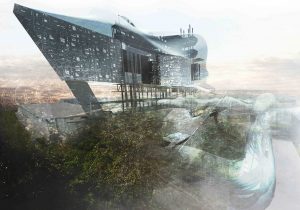On January 25, 2017, after having demonized undocumented immigrants during his election campaign, the President of the United States, Donald Trump, signs an executive order “Enhancing Public Safety in the Interior of the United States” [1]. It dramatically expands the mandate of federal immigration authorities and threatens sanctuary cities’ ability to protect immigrants of illegal status. Among other anti-immigration policies, the order restores and strengthens two programs from previous administrations extending to local police the enforcement powers of federal immigration law and directing the Department of Homeland Security to weekly publish crimes committed by aliens in sanctuary cities. Since the signing of the executive order, arrests and deportations have increased by 40%.
Resistance to deportation has been led in large part by faith organizations that draw from a long tradition of granting sanctuary. Following the ancient religious concept of sanctuary, churches have a duty to shelter people fleeing persecution. In the 1980s, US congregations of different faiths inaugurated a social movement that resisted federal law by offering direct sanctuary, hiding, providing shelter, food, transportation and legal assistance to refugees fleeing violence from the civil wars and collapsing economies in El Salvador, Guatemala, and Nicaragua, only to be met with discriminatory federal laws and regulations in the United States.
In 2007, activists and religious leaders in various cities, including New York, Chicago, and California, working with immigrant organizations, envisioned a New Sanctuary Movement (NSM) to engage faith-based groups specifically in support of the 12 million undocumented immigrants living in the U.S. Founding members of the NSM included clergy and congregations from Christian, Jewish, and Muslim traditions. Also in 2007, the New Sanctuary Movement of Philadelphia was launched in opposition to the Obama administration’s aggressive deportation policies, and with a commitment to “end injustices against immigrants regardless of immigration status, express radical welcome for all, and ensure that values of dignity, justice, and hospitality are lived out in practice and upheld in policy” [2]. Growing remarkably since the election of Donald Trump, the NSM “organizes member congregations from diverse faith backgrounds who come together around shared faith values” [3].
Strategies of detention vs. tactics of resistance. Research Part 1
In 2011, the Department of Homeland Security passed a policy geared towards limiting ICE interventions at sensitive locations that include spaces of worship:
“The policies provide that enforcement actions at or focused on sensitive locations such as schools, places of worship, and hospitals should generally be avoided, and that such actions may only take place when (a) prior approval is obtained from an appropriate supervisory official, or (b) there are exigent circumstances necessitating immediate action without supervisor approval. The policies are meant to ensure that ICE and CBP officers and agents exercise sound judgment when enforcing federal law at or focused on sensitive locations, to enhance the public understanding and trust, and to ensure that people seeking to participate in activities or utilize services provided at any sensitive location are free to do so, without fear or hesitation.” [4]
Although this seems to benefit, under vague terms, the work of the NSM, under federal law, places like churches, mosques and synagogues are still considered public spaces where authorities could enter and conduct law enforcement. ICE, however, has continued to follow the sensitive locations policy rather than enter into confrontations.
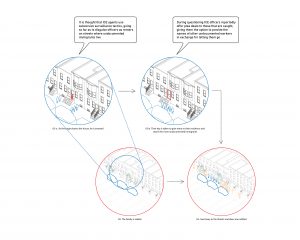
Strategies of detention vs. tactics of resistance. Research Part 2
Temporary Autonomous Networks: The Architecture of Real Utopia
The same month as President Trump’s executive order, an architecture studio called Temporary Autonomous Networks: The Architecture of Real Utopia was launched by me, Eduardo Rega Calvo, at the Department of Architecture at the University of Pennsylvania’s School of Design [5].
The studio, in one of its streams of investigation, presents spatial tactics that oppose the current extremist anti-immigrant agenda of Trump’s administration and imagines an alliance with the NSM of Philadelphia. This fictitious alliance learns from current and past struggles, proposing architectural interventions of resistance and cooperation in the protection of universal human rights of undocumented migrants.
The studio explores how grassroots activists, like the NSM, create Temporary Autonomous Zones (TAZs) sheltered from and resistant to ICE enforcement. In the words of anarchist author Hakim Bey, TAZs are created through “an uprising which does not engage directly with the State, a guerrilla operation which liberates an area (of land, of time, of imagination) and then dissolves itself to re-form elsewhere and elsewhen, before the State can crush it” [6]. The studio expanded the interpretation of the TAZ as a tactic that erodes capitalism through local community enhancement and cooperativism, justice, and defense of human rights.
Another important concept that frames the studio is that of the Real Utopia. According to Erik Olin Wright, Real Utopias “can be found wherever emancipatory ideals are embodied in existing institutions and proposals for new institutional designs. They are both constitutive elements of a destination and a strategy” [7]. Examples of Real Utopias include post-capitalist economic models such as workers cooperatives, peer-to-peer collaborative modes of production and open libraries. While speculating on alternative institutional/economic/political designs that challenge the status quo, a Real Utopian narrative for the studio would define architecture’s role in the network of a progressive grassroots organization actively pursuing justice.
Learning from, and attempting to imagine a contribution to the NSM, the studio aims to provide alternative imaginaries at a time when state boundaries are fortified, where people fleeing catastrophe are criminalized, and where so-called democracies have the power to decide if they comply or not with universal human rights of immigrants, refugees, and asylum seekers. In opposition to these practices of exclusion by nation states, the project aligns itself to the proliferation of postnational universalistic solidarity movements, specifically the New Sanctuary Movement of Philadelphia, working to protect the human rights of immigrants that are excluded from democracy and increasingly targeted and raided by the ICE.
Strategies of detention vs. tactics of resistance. Research Part 3
The studio applies this conceptual framework to a site in the Parkside neighborhood of West Philadelphia, characterized by vacant lots and a lack of public services, and isolated from surrounding neighborhoods by rail lines, Fairmount Park and the Philadelphia Zoo.
In our studio, maps, diagrams, and atlases are used as tools capable of connecting urban and architectural expertise to forums outside of our field. After selecting grassroots organizations operating in Philadelphia, like the NSM, students collected information through research and interviews to communicate the organizations’ history, mission, and struggle, as well as their effects on the built environment. Students working on the NSM mapped the unstable history of immigration policies in the United States — its constant shifts between criminalizing, detaining and deporting undocumented migrants on the one hand, and granting them amnesty on the other. By interviewing NSM members and other community activists, they identified and represented protocols, architectures, and technologies of undercover surveillance, policing, raiding, detention and deportation by the ICE. They also represented the spaces, tactics, and processes of self-defense and human rights protection performed by the NSM — including actions like the Sanctuary in the Streets raid responses, the provision of safe spaces, and legal support.
As part of the studio methodology, and in response to the research, every group of three students developed three phases of a common and negotiated project as a Real Utopia. Throughout the rest of the semester, each student refined one temporal-architectural phase and reported back to the group’s common architectural narrative.
The Urban Sanctuary Network project that follows explores the subversive architectural potential of the New Sanctuary Movement. What would be the role of architecture if this network materialized so as to disrupt the actors fighting against it? What rules would have to be followed, misread and/or subverted, and how would the process unfold in the decades to come?
Phase 01: 2012, Establishing and Defending the Network by Kurt Nelson
Nodes within proposed underground network: church/library and row homes
On June 15th, 2012 the Deferred Action for Childhood Arrivals policy was passed, allowing those who arrived in the US before their 16th birthday to not fear deportation. It is this context that provides the framework for the first phase of the Urban Sanctuary Network project.
Because of the prominence of ICE surveillance in the undocumented immigrant community, privacy is a valuable resource. Remaining in a single dwelling while under surveillance is risky, so an ideal situation would allow one to discretely relocate as necessary. Vacant houses in Parkside provide an opportunity to do this, using basements as entrances to tunnels that connect to one other and to nearby member churches. The aboveground portion of the house is retrofitted to incorporate instantly transformable architectural devices that keep the space habitable in its original program, but also adaptable to provide an escape below ground. By doubling walls, floors and ceilings, and using the interstices to build the network’s infrastructures, houses in the underground system remain entirely indistinguishable from those outside of it.
Underground network’s tactics of disappearance: double walls, basements and tunnels
Taking advantage of ICE’s existing policies on sensitive locations, member churches of the NSM are key sites of intervention. In its capacity to act as a filter, protection and node of access to the network, the church receives the program of the library as an add-on, where public neighborhood spaces for reading, archiving, and learning are combined with hidden areas for training, organizing, and governing this new sanctuary real utopia. The network connecting to the church serves as a way to allow free circulation around the city without fear of ICE agents arresting undocumented workers. By connecting to the basements of vacant houses, the project provides discreet housing to those that are being tracked by the ICE. As the network expands, certain trusted businesses begin to serve as access points, using their high levels of activity to help undocumented immigrants get lost in the crowd and escape potential raids by the ICE, performing the same function as that of the crowds at a sanctuary church’s Sunday mass.
As a Temporary Autonomous Zone, the network aims to be independent. All of its resources and their management are separated from the rest of the city, and operate in parallel to those established by official systems of state governance.
Phase 02: 2022, Pop-up Pod Decoys by Grace Soejanto
Occupations and reactivation of vacancies through movable and recombinable architectures built on demand
Predicting a progressive turn in American politics after Trump’s four-year term and the awakening it triggers on in society, Pop-up Pod Decoys imagines a scenario where new policies are passed that protect the human rights of undocumented immigrants by opening up initiatives for integration. In this context, the Urban Sanctuary Network project externalizes some of its connections to selectively merge with the public sphere, while creating mechanisms to protect itself from future potential threats posed by other conservative administrations and their political agendas on immigration.
In this welcoming environment towards undocumented immigrants, Parkside’s Community Development Corporation establishes an alliance with The Urban Sanctuary Network project, collaborating on initiatives like the Parkside community land trust, building co-op, food co-op and urban farm. Members of the underground Urban Sanctuary Network project are now openly considered neighbors of Parkside, participating in cooperative economic models, and strategically joining their efforts, goals and resources to Parkside’s. The architectures of this incipient process of integration have the ability to grow, move, and adapt in response to the evolution of a post-capitalist neighborhood-based economic experiment. The northeast tower of the library built in Phase 1, is now converted into a vertical building yard where small-scale architectural components (pods) are fabricated on demand. These pods are propagated to serve various cooperative economic purposes (from food coops to urban farming facilities), and to activate the neighborhood’s vacant lots and buildings (play and culture).
Moments of exposure of the network above-ground, designed to strengthen its ability to disappear and reorganize
The architectures of Phase 2, however, are far from innocent. Aware of the history of violent political shifts in regard to immigration policies, The Urban Sanctuary Network project embeds a disguised intelligence in its deployable architectures that can revert to its underground mode when hostilities arise: populous pop-up programming offers decoys; architectural components such as structural frames and pods are designed with hidden inhabitable spaces that can connect to the underground network, multipling possible escape routes; blindspot-spaces in architectural devices can be interconnected to each other and to Phase 1 underground spaces to make the network more agile, unpredictable and ungraspable, capable of reconfiguring itself before the State can crush it.
Phase 03: 2100 Spaces of Voluntary Exile by Prince Langley
The interior of the previously hidden network of the undocumented, expanded and transformed to host society A, while doubling as a memorial of the immigration struggle
In the year 2100 inequality has reached its peak and two societies have come to exist: Society A lives in an inescapable interior architecture governed by digital networks, protected from the hostilities of an increasingly unstable climate, and unaware of another society B of undocumented communities on the exterior that organize outside the systems of capitalist control. Through extreme structural denial, society A has been made to believe that they’ve come to terms with their history of human rights violations. A manifestation of this can be identified in how the former underground networks of the undocumented have now been turned into a rhizomatic museum/memorial of the oppressed, which intersects a continuous interior of both public and private artificially controlled environments. The former church and sanctuary sites allow visitors to digitally recreate scenarios of the past and witness how the undocumented lived. However, the hyper-connected society A is itself the victim of a system of control governed by digital networks.
Society A’s interior memorial of the formerly hidden architectures (above); Society B’s voluntary exile into a toxic exterior Zone (below)
Society B lives invisible to Society A due to its members’ deliberate disconnection from the digital realm. Society B is composed of the undocumented of the 22nd century. Having developed evasive tactics to live outside has led them to develop primitive modes of existence that constitute a radical subversion of the artificially controlled interior status quo. They inhabit fields of geographic scars, violent and overgrown landscapes, toxic and forbidden regions, a continuous catastrophic Zone [8] that is the product of advanced climate change and capitalist exploitation. Permanently wearing breathing apparatuses to survive, members of Society B utilize discarded architectural elements from prior phases to divert resources from Society A. This new future renders the undocumented as those emancipated from, but facing the consequences of, a hyper-capitalist society.
Bird’s-eye view of the continuous interior city
Eduardo Rega Calvo is an architect, urban designer and researcher based in New York. Having taught at GSAPP, RISD, Parsons and Pratt, he is a graduate architecture faculty at PennDesign, at the University of Pennsylvania where he teaches seminars, design studios and a summer program. He completed the Master of Science in Advanced Architectural Design with Honors for Excellence in Design from Columbia University. The Agency of Autonomy: Tools for an Architecture of Translation is the title of his PhD dissertation in Architectural Design at ETSA Madrid, currently in progress. He holds a professional degree in architecture and urbanism from the University of Las Palmas. His research and design work focuses on architecture’s capacity to translate, operate in and contribute to insurgent social and political movements.

